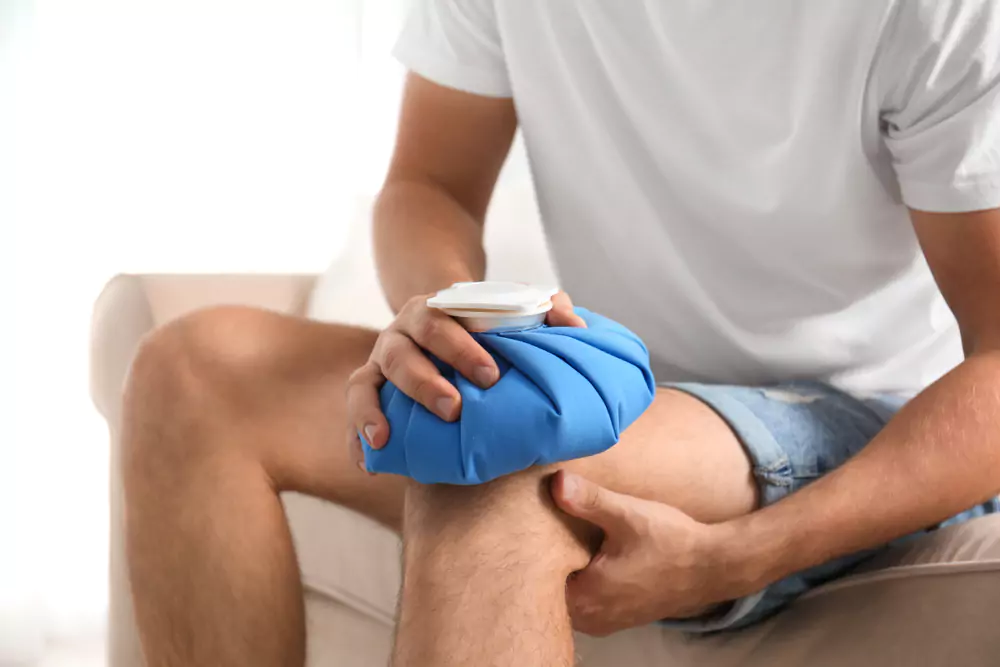Applying ice to an injured knee is one of the most effective ways to treat pain, swelling, and inflammation. Proper icing technique helps reduce blood flow to the injured area, numbing pain receptors and preventing further injury. This article provides a step-by-step guide to safely and effectively use ice therapy for knee problems.
Understanding the Proper Technique for Applying an Ice Pack to the Knee
The first step is to prepare your materials. You will need:
- An ice pack, gel pack, or bag of ice cubes
- A towel or cloth
- Tape or an ice pack wrap (optional)
Make sure to wrap the ice pack in a thin towel before applying it to your skin. This helps prevent frostbite or skin damage. Never place ice directly on the knee!
When ready, apply the wrapped ice pack to the sore or swollen area for 10-20 minutes. Make sure to move it around slightly during the session and avoid keeping it in one spot. You want even coverage. Elevating your leg can help reduce swelling as well.
Many patients find taping or wrapping the ice pack around the knee provides compression. This helps hold the pack in place hands-free. But do not wrap too tightly! Make sure circulation is not cut off.
How Long and How Often Should You Ice Your Knee?
Experts recommend icing for 10-20 minutes per session, 3-6 times per day during the initial 48-72 hours after injury. This acute phase is when inflammation peaks.
Apply ice as soon as possible after the injury occurs. Begin a regimen of ice every 2-3 hours for 20 minute sessions. Continue this for 2-3 days post-injury. The cold constricts blood vessels, reducing blood flow to the knee tissue.
As swelling subsides, you can reduce icing to 2-3 times daily for 10 minutes. Apply after activities that aggravate the joint. Icing too much can also impair healing, so follow these guidelines.
The Benefits of Ice Therapy in Reducing Inflammation and Pain
Applying ice is helpful for a variety of knee problems including sprains, strains, tendonitis, arthritis flare-ups, and post-operative swelling. The cold temperature has the following therapeutic effects:
- Constricts blood vessels and reduces blood flow to the knee tissue. This decreases inflammation, swelling, and internal bleeding.
- Slows down the body’s metabolic processes and numb nerve endings in the skin’s surface. This temporarily reduces pain signals.
- Prevents further injury by making the tissue less sensitive and providing analgesic effects.
The result is a decrease in inflammation and pain. Be sure to balance icing with periods of rest to allow tissue repair and restoration of normal blood flow.
Precautions and Tips for Using an Ice Pack Safely on Your Knee
While ice is helpful for knee injuries, you need to take a few precautions:
- Never apply ice directly to the skin. This can cause frostbite. Always have a barrier like a towel.
- Do not use ice if you have poor circulation or numbness. This could prevent you from noticing frostbite.
- Avoid icing over areas of skin that are unhealthy or infected.
- Never fall asleep with ice on your knee! This can lead to tissue damage.
- If ice aggravates your injury or causes increased pain, stop treatment.
- Follow time limits for icing sessions and allow tissue to warm between applications.
- Combine icing with other R.I.C.E. therapy elements like rest, compression, and elevation.
Using proper technique allows you to harness the healing power of ice safely. Consult a doctor if you have concerns.
When to Seek Medical Attention for Your Knee Injury
In most cases, knee injuries can be treated effectively at home with R.I.C.E. therapy and over-the-counter medications. But some situations require medical assistance:
See a doctor if you experience:
- Deformity or inability to bear weight on the leg
- Extreme pain, swelling, redness, or warmth
- Numbness, tingling, or color changes in the knee or leg
- Popping, locking, or instability in the knee joint
- No improvement in pain or function after a few days of home treatment
It is also wise to follow-up with a doctor after any significant knee trauma like a bad fall or sports injury. Diagnostic imaging may be required to check for fractures, ligament tears, or other damage. Early treatment can prevent complications.
Do not hesitate to visit a clinic, urgent care, or emergency room if you have concerns about a knee injury. Getting prompt medical attention provides the best chance for proper healing.
Other Alternatives to Ice Therapy for Knee Injuries
While ice is frequently recommended, there are other conservative treatment options for injured knees:
- Heat therapy with warm compresses or a heating pad can relax muscle tension and increase blood flow. Use caution as heat can exacerbate acute swelling.
- Compression sleeves provide mild pressure and support to the joint while also limiting swelling. These are easy to wear during daily activities.
- Elevation keeps the knee raised above heart level when resting. This utilizes gravity to drain fluid away from the knee tissue.
- Pain relievers like NSAIDs (non-steroidal anti-inflammatories) reduce both pain and inflammation. Consult your doctor before use.
- Bracing stabilizes the joint and limits harmful movements that could further injure the knee. Braces also provide compression.
- Consult your doctor about integrating these options into your treatment plan. Multimodal therapy often provides the best results. Be patient through the healing process.
Conclusion:
Icing is a simple, affordable, and effective method to treat common knee injuries like sprains, strains, and contusions. Using proper technique is key. Follow guidelines for application duration and frequency during the initial 48-72 hours post-injury when inflammation peaks. Combining ice with other conservative measures can maximize healing. Recognize when to seek medical attention for optimal recovery. Be diligent with R.I.C.E. therapy and you will be back on your feet in no time!



